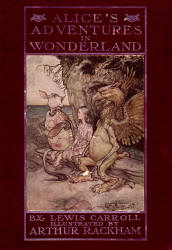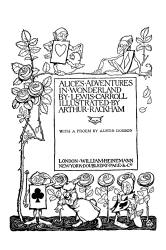Alice's Adventures in Wonderland
(1907)
Illustrated by Arthur Rackham
Alice's Adventures in Wonderland was penned by
Rev Charles Lutwidge Dodgson - also known as Lewis Carroll - in 1863. The tale arose from a story Dodgson had improvised during a row up the Thames with his colleague, Rev Robinson Duckworth, and three little girls, the Liddell sisters: Lorina Charlotte; Alice Pleasance; and Edith Mary.
In The Bookman (February 1908: Dodd, Mead and Company, New
York), Philip Loring Allen explored Rackham's illustrative contribution to Carroll's modern fairy tale saying:
If there is one place in the world or out of it where vested
rights ought not to be respected, it certainly
is Wonderland. If ... Mr Rackham [has] ... something to add
to our imperfect knowledge of that
delectable country ... [he is a] benefactor.
Loring Allen describes Rackham's illustrations throughout his
critique in the following manner:
... Rackham alone has drawn Alice at that remarkable
crisis when she has nibbled the right-hand bit
of mushroom, and shutting up suddenly like a telescope, has
received "a violent blow underneath
her chin from her own foot" ...
... Rackham's lady, with her high beak-nose, her ermine,
ostrich plumes and false curls is every inch
a Duchess, probably a Dowager Duchess ...
... Rackam's [Mock Turtle] is ... delicate and anaemic,
pensive and sentimental ...
... Rackham's Caterpillar ... is the only caterpillar that
corresponds strictly to the specifications ... [his]
snuffy, loose-lipped, spectacles smoker wears the real air of
authority. He cannot be imagined as
ever turning into a butterfly or moth. If he turns into
anything it will be a bookworm. His eyes are dim
with study and introspection. He is probably of German
extraction and his valedictory observation to
Alice, "You'll get used to it in time," sounds like the
answer to the Welträtsel.
... The real daring change made by Rackham is in bringing
this little heroine down to date. Most of
us doubtless will continue to love the old Alice best, but
the modern little figure does bear one
message of its own. It tells us that the gate of Wonderland
has never been closed, that it never will
be closed, and that to the children of the twentieth century,
old and young, as to their children and
grandchildren, it is still given to eat now and then of the
magic fruit of the Amfalula tree in whose
boughs the Dinkey bird sings.
|
%20(Profile).jpg)


%20(sample).jpg)
%20(sample)%20(300).jpg)
.jpg)
.jpg)
.jpg)
.jpg)
.jpg)
.jpg)
.jpg)
.jpg)
.jpg)
.jpg)
.jpg)
.jpg)
.jpg)